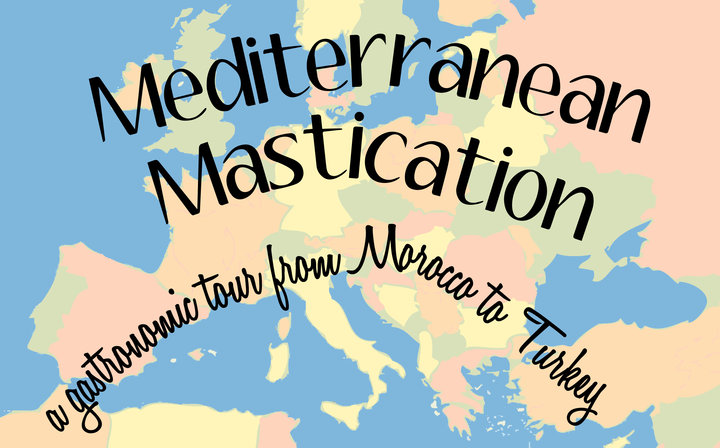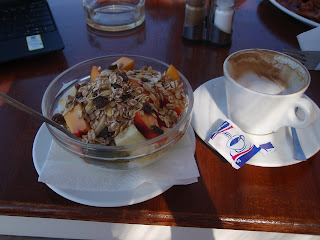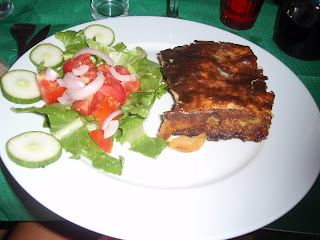G'day Masticators and welcome to the last Mediterranean country on this gastronomical affair - Turkey!
As I found with Greece, 1.5 weeks is just not enough time for this massive country which has a cuisine to match its size. However I gave it a good crack so let's get stuck into it.
Turkish cuisine is largely the heritage of Ottoman cuisine, which can be described as a fusion and refinement of Central Asian, Middle Eastern and Balkan cuisines. The Ottomans fused various culinary traditions of their realm with influences from Middle Eastern cuisines, along with traditional Turkic elements from Central Asia (such as yogurt), creating a vast array of specialities - many with strong regional associations.
BREAKFASTA typical Turkish breakfast consists of cheese (usually beyaz peynir - similar to feta), butter, olives, hard boiled eggs, tomatoes, cucumbers, green capsicum, reçel (jam/marmalade; a preserve of whole fruits) and honey.

A common Turkish speciality for breakfast is called menemen, which is prepared with roasted tomatoes, peppers, olive oil and eggs.

Another on-the-go breakfast commonly eaten in Turkey is the simit, a type of ring-shaped bread covered with sesame seeds. Simit can be eaten plain or with cheese, butter or marmalade.
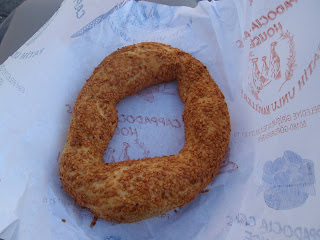 MEALS (Lunch/Dinner)Meze
MEALS (Lunch/Dinner)MezeTurkish meze often consist of beyaz peynir (literally "white cheese"), kavun (sliced ripe melon), acılı ezme (hot pepper paste often with walnuts), haydari (thick strained yoghurt like the Levantine labne), patlıcan salatası (cold aubergine salad), kalamar (calamari or squid), enginar (artichokes), cacık (yoghurt with cucumber and garlic), pilaki (various foods cooked in a special sauce), dolma or sarma (rice-stuffed vine leaves or other stuffed vegetables, such as bell peppers), and köfte (meatballs).
FYI - The English word "mezze" was borrowed from the Greek "mezés", which was borrowed from Turkish "meze".

 Kebab
KebabThe word kebab refers to a wide variety of meat dishes in terms of preparation & content. I had a go at trying as many different styles as I could!

Buğu kebabı is a Turkish kebab dish which is prepared in an earthenware casserole.

Testi kebab is a dish from Central Anatolia and the Mid-Western Black Sea region, consisting of a mixture of meat and vegetables cooked in a clay pot or jug over fire (testi means jug in Turkish). The pot is sealed with bread dough or foil and is broken when serving.

Döner kebab, literally "rotating kebab" in Turkish, is sliced lamb, beef or chicken, slowly roasted on a vertical rotating spit. It can be served in a durum wrap or on a plate with various condiments & side dishes.


Shish kebab ("shish" is from Turkish meaning "skewer") is a dish consisting of meat threaded on a skewer and grilled. Any kind of meat may be used; cubes of fruit or vegetables are often threaded on the skewer as well. Typical vegetables include eggplant, tomato, bell pepper, onions, and mushrooms.
A variation of this is the Adana kebap is with hand-minced meat mixed with chili on a flat wide metal skewer. This kebab is associated with Adana region although very popular all over Turkey.

A full Turkish kebab meal. Adana kebab on pide (also known as berberi) flatbread, served with ayran (salty youghurt drink - very popular in Turkey), radish, parsley, lemon, green salad, onion salad, grilled tomatoes, and peppers.
VegetablesA vegetable dish can be a main course in a Turkish meal. A large variety of vegetables are used, such as spinach, leek, cauliflower, artichoke, cabbage, celery, eggplant, green and red bell peppers, string bean and jerusalem artichoke.
Dolma is the name used for stuffed vegetables. Like the vegetables cooked with olive oil as described above dolma with olive oil does not contain meat. Many vegetables are stuffed, most typically green peppers (biber dolması), eggplants, tomatoes, courgettes, or Zucchini in the U.S. (kabak dolması), vine leaves (yaprak dolması).

Vegetables are also common side dishes, usually cooked with tomato, olive oil, garlic & served at room temperature in the cooking juices (see beans on left below).
 BREADS
BREADSTurkish cuisine has a range of savoury and sweet pastries. Dough based specialities form an integral part of traditional Turkish cuisine. The use of layered dough is rooted in the nomadic character of early Central Asian Turks.
Börek is the general name for salty pastries made with yufka (a thicker version of phyllo dough), which consists of thin layers of dough.Boreks are usually stuffed with cheese, meat or vegetables.


Sigara böreği (cigarette)generally prepared with different kinds of cheese.
Pide a broad, round and flat bread made of wheat. Pide, which can be made with minced meat (together with onion, chopped tomatoes, parsley and spices), spinach, white cheese, pieces of meat, and eggs put on rolled-out dough, is one of the most common traditional stone-baked Turkish specialities.

Gözleme is a food typical in rural areas, made of lavash bread or phyllo dough folded around a variety of fillings such as spinach, cheese and parsley, minced meat or potatoes and cooked on a large griddle.

 PASTRIES/DESSERTS
PASTRIES/DESSERTSOne of the world-renowned desserts of Turkish cuisine is baklava. Baklava is made either with pistachio or walnut.


The other well-known dessert originating in Turkey is the lokum (Turkish delight), which was eaten for digestion after meals and has a range of varieties - the most popular flavours incorporate pistachios & hazelnuts.

Of course good old fashioned fruit never goes astray either. Pomegranate juice stalls dot the streets of Istanbul - fresh & delicious.


Vodka watermelon, Turkish style!
DRINKSAlthough the majority of Turks profess the Islamic religion, alcoholic beverages are as widely available as in Europe.There are a few local brands of lager such as Marmara (6.1%!) and Efes Pilsen.


Rakı, a traditional alcoholic beverage flavoured with anise, is the usual drink with meze, fish or kebabs. It is a clear spirit but when mixed with water turns a cloudy milky colour.

Ayran (salty yoghurt drink) is the most common cold beverage, which may accompany almost all dishes in Turkey.

Turkish coffee is a world-known coffee which can be served sweet or bitter. prepared by boiling finely powdered roast coffee beans in a pot (cezve), possibly with sugar, and serving it into a cup, where the dregs settle. The name describes the method of preparation, not the raw material; there is no special Turkish variety of the coffee bean.

Apple tea is also widely sold, however it is more of a tourist gimmick than anything else. However the Turks love their tea, served strong, black & with at least 2 sugar cubes.
 SNACKS
SNACKSStreet food is popular and widespread, especially in Istanbul where each corner offers either simits, corn (steamed & grilled) and raw almonds om ice (odd?!)



Phew, another epic food post! I am now in the land of enormous pork knuckles & 1L beer steins (Munich), and although not strictly Mediterranean you can expect a post in the coming days!
Until then - PROST!
CW x





 Hendl (roast chicken) en masse
Hendl (roast chicken) en masse Traditional Bavarian beer snack - fresh sliced garden radish served with buttered bread and chives
Traditional Bavarian beer snack - fresh sliced garden radish served with buttered bread and chives Brezn (Pretzel)
Brezn (Pretzel) Half crispy knuckle of pork with potato dumpling, cabbage salad and dark beer gravy
Half crispy knuckle of pork with potato dumpling, cabbage salad and dark beer gravy Steckerlfisch (grilled fish on a stick)
Steckerlfisch (grilled fish on a stick)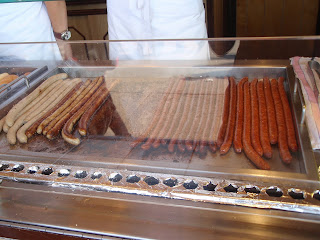 Würstl (sausages)
Würstl (sausages)